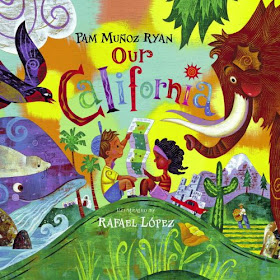Cinco Puntos Press, 2014
high school-up
Mexican American
As I’ve made my way through the dozens of books nominated for the Cybils Award in YA Fiction this year—I’m now up to 128—a few have come to stand out. One of my favorites is Isabel Quintero’s debut novel, Gabi: A Girl in Pieces. Quintero’s novel shows that some of the most interesting, innovative, and honest titles come from the small press world.
The novel chronicles Gabi Hernandez’s senior year in high school. Because she skipped a year, she is a little younger than her peers, and she watches as many of them take risks and make difficult or outright bad choices. The story begins with her best friend Cindy’s unplanned pregnancy—the result, Cindy later reveals, of a date rape. Gabi’s mother, and many other mothers in their community, had gotten pregnant by accident and either had had children outside of marriage or married too young, and they warn their daughters: “‘Ojos abiertos, piernas cerradas.’ Eyes open, legs closed.” Still, the girls live in a hyper-sexualized environment that reinforces traditional gender roles and the double standard for women and men. Gabi chafes against the hypocrisy, as does her other best friend Sebastian, who is kicked out of his house when he dared to come out as gay. Gabi’s mother struggles to support the family while her father battles a meth addiction. Gabi’s efforts to connect with her father and to remember the good times are among the most poignant parts of a beautifully written and emotionally gripping story.
Gabi’s voice, her spunk, and her growing acceptance of who she is—a fat girl who seeks comfort in food while trying to live life on her own terms—give Quintero’s novel the kind of unforgettable quality that will make it a classic for teen and adult readers. Structured as a yearlong diary, Gabi: A Girl in Pieces moves forward through vignettes. Poems, play scripts, letters to her father and boyfriend, a hilarious graphic novel, and a list of “INSTRUCTIONS FOR UNDERSTANDING WHAT BOYS WILL BE BOYS REALLY MEANS” are interspersed with the diary entries and reflect perfectly Gabi’s emotions and passion. For example, one of the sardonic instructions reads, “When a girl says no, you might want to consider your position. I don’t think she meant yes. But I’m a girl, so what do I know? But because boys will be boys, you don’t really have to think about it.”
Gabi juggles her own ambitions with the expectations her community and the wider society have for her, and Quintero does a superb job of exploring the tangle of gender roles, body image, and sexuality that teenage girls face. But while Quintero explores universal themes, her language and well-chosen details give this novel a cultural specificity and richness so that it speaks directly to young Latinas while allowing others into the world of its author and protagonist. For instance, in talking about her light skin and how people have trouble believing she’s of Mexican heritage, Gabi observes:
This skin thing always pisses me off. What I need is a nopal on my forehead to let the world know about my roots. One of those flat cactus plants that my grandpa grew behind his house before he died—nopal en la frente. Yup. That would solve all my problems. It would say, “This light-skinned, White-looking young lady is of Mexican descent. Really, she is. Yes, she speaks Spanish. And English too. She is a sight to see, folks, a real marvel. (Unless you travel to Mexico, where there are lots more like her.)” The nopal would solve those problems.
The Spanish is not italicized, nor is there a glossary. One language is not privileged over the other, and readers are trusted to understand meaning from the context. The narrative flows seamlessly and lyrically between languages.
Award committees take note—this is an amazing novel from a bright new star! Highly recommended.
—Lyn Miller-Lachmann
(published 12/26/14)


